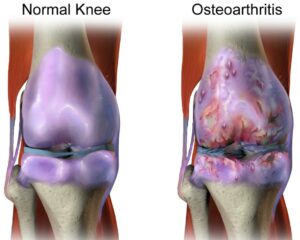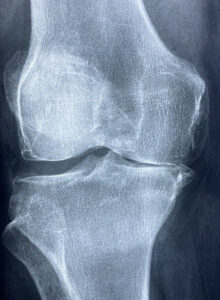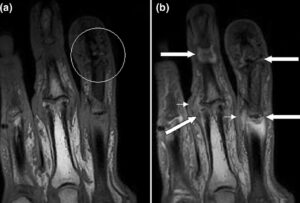 I’ll bet you didn’t know that while Rheumatoid Arthritis pain is debilitating to almost 3 million Americans. But Osteoarthritis, a much more severe and common form of arthritis, is a very ugly part of over 27 million American’s lives. That is more than 10% of the USA population.
I’ll bet you didn’t know that while Rheumatoid Arthritis pain is debilitating to almost 3 million Americans. But Osteoarthritis, a much more severe and common form of arthritis, is a very ugly part of over 27 million American’s lives. That is more than 10% of the USA population.
Fortunately YOU don’t HAVE to be in pain from either. This page will give you more info about rheumatoid arthritis. Some of the information is about arthritis in general. Some of it is about Osteoarthritis. But all of it is info you need to know is here to help eliminate the pain.
The medical definition of arthritis is very broad. It is simply, “Inflammation of a joint.” That simple inflammation can cause devastating results if not treated right. The fact is that there are over one hundred medical conditions that can be categorized as some sort of ‘arthritis’.
There Are Many Different Types of Arthritis
Most people who are reading this for information regarding arthritis have much more than just stiffness in their joints. They, most often, have one of five main medical conditions related to arthritis. These five are: Osteoarthritis, Rheumatoid Arthritis, Psoriatic Arthritis, Gout, and Lupus.
Gout is a buildup of uric acid crystals in the joint- usually toes or feet. Lupus is an autoimmune disease that can affect many organs of your body. It is sometimes confused with arthritis because it may affect a person’s joint. Both Gout and Lupus will be considered in a completely different informational article. Here we will discuss the three medical conditions that are most often called ‘Arthritis’.
What is Osteoarthritis?
Osteoarthritis is the most common kind of arthritis and is often called ‘degenerative joint disease’. It is basically the ‘wear and tear’ on your joints from overuse or excessive stress on your joints.
 The Cause of Osteoarthritis
The Cause of Osteoarthritis
Osteoarthritis happens when the cartilage in your joints break down completely leaving your bones to rub on each other. It can cause serious pain and if left untreated can cause very long-term damage. As I mentioned above, over 27 million Americans have some level of Osteoarthritis.
Osteoarthritis is quite often preventable. It is usually caused by a person:
- Having unhealthy eating habits
- Not getting enough exercise
- Being overweight (often caused by eating habits)
- Smoking tobacco
- Drinking too much alcohol
- Allowing too much stress in their life.
If you don’t eat healthy (most American’s don’t) and don’t get enough exercise you have a much larger chance of being overweight and that can put unnatural stress on especially the joints that bear weight like your knees, hips, feet and spine. So the takeaway here is to try not to gain too much weight if that is possible for you.
Symptoms of Osteoarthritis
The symptoms of Osteoarthritis are the same (or very similar) to the other types of Arthritis but are just ‘wear and tear’ rather than some sort of an unpreventable disease. These symptoms might include:
- Pain, or tenderness in a joint(s) of your body.
- Tenderness or loss of flexibility in a joints(s) of your body.
- Swelling and/or excess warmth in a joint of your body.
Treatment for Osteoarthritis
People who suffer from Osteoarthritis can have deep and aching pain and have difficulty doing ‘normal’ tasks such as climbing stairs, walking, bending over or even combing their hair. The weight-bearing joints can sometimes become swollen, lose their range of motions and can even sometimes become warm when you feel the area. Resting, or not using, those joints for a little while along with eating the proper foods can help reduce the amount of pain and allow the cartilage to begin healing itself.
Does that sound familiar to you? No, that doesn’t mean that you have Osteoarthritis. It may simply mean that you’re getting older and/or that you’re getting low on synovial fluid, that requires fairly constant movement to keep your joints flexible, especially when you get older.
What is Rheumatoid Arthritis?
Rheumatoid Arthritis, on the other hand, is an autoimmune disease, meaning that your immune system is attacking a part of your body. In this case it is attacking your synovium, the soft tissue that lines surface of your joints. RA, as it is often called, may happen at any age but is most prevalent after a person is 30-60 years old. About 1% of people in the USA have RA and women are roughly three times more likely to have RA than men.
If you have Rheumatoid Arthritis, it is really important to do whatever you have to do in order to reduce the inflammation in your joints. If you don’t have what it takes to do it naturally (as is shown on the Natural Cure for Arthritis page of this website) you should at least take some inflammation reducing medications in order to reduce your pain and also prevent joint damage.
 The Cause of Rheumatoid Arthritis
The Cause of Rheumatoid Arthritis
Medical doctors don’t know what causes Rheumatoid Arthritis because they don’t know what causes autoimmune diseases and Rheumatoid Arthritis is an autoimmune disease.
Symptoms of Rheumatoid Arthritis
A person with Rheumatoid Arthritis might have stiff, tender, swollen or warm-to-touch joints that are usually worse in the morning or after not being used for a while. They might also have loss of appetite, a fever or chronic fatigue but these symptoms could often be signs of something other than Rheumatoid Arthritis.
If you’re in the early stages of Rheumatoid Arthritis, your small joints, like your fingers or toes, might be affected before larger ones. As it progresses it may begin affecting knees, wrists, ankles, elbows, shoulders or hips.
About one in every five people who have rheumatoid arthritis end up having bumps or lumps on their skin called ‘rheumatoid nodules’. The nodules can be firm or soft and either painless or very painful, depending on whether they form near a nerve or not. Most often they form close to joints. They can be almost undetectable like a pea or very noticeable like a walnut under your skin.
One symptom of Rhematoid Arthritis that is usually different than symptoms of other types of Arthritis is that it is usually symmetrical. In other words, if your right hand is affected, your left hand will most likely also be affected; if your left elbow is affected, your right elbow is also likely to be affected; and so on. The reason for this is because the cause of Rheumatoid Arthritis comes from a faulty immune system rather than normal ‘wear and tear’.
There are other, non-joint related symptoms that affect up to 40% of those who have Rheumatoid Arthritis. This can include skin, heart, eyes, and even nerves, heart, kidneys and lungs. The severity of the symptoms vary and can even seem to ‘go into remission’ from time to time. But Rheumatoid Arthritis is nothing to ignore. If not treated in time or correctly damage to joints often happens.
Treatment for Rheumatoid Arthritis
The most important things you can do is to realize that your immune system is attacking a part of your body and change whatever you need to in order to get your immune system back in line. That is an entirely separate and exhaustive topic all on its own.
While all the different types of arthritis are different, the most effective treatment for any type of Arthritis is to make sure your immune system is operating right and that you aren’t hurting yourself by eating things that cause inflammation to any part of your body. You can find out more about natural treatments on the Natural Cures pages on the menu above.
What is Psoriatic Arthritis?
The third type of arthritis is Psoriatic Arthritis. It, like Rheumatoid Arthritis, usually starts between the ages of 30 and 50, but is possible to start in early childhood. It is basically not as severe as Rheumatoid Arthritis (an autoimmune disease where your immune system attacks your joints) but is similar in that it comes from your immune system not working right and allowing inflammation in your joints.
 The Cause of Psoriatic Arthritis
The Cause of Psoriatic Arthritis
Medical doctors don’t know what causes this variation of arthritis either. What they do know is that it is related to Psoriasis, which is a disease causing inflammation of the skin when your immune system is not working right. Only about 20%-30% of those who have Psoriasis also end up with Psoriatic Arthritis.
Symptoms of Psoriatic Arthritis
If you get Psoriatic Arthritis, it might affect a single joint or could affect more than one. Your fingers and toes might swell and your fingernails or toenails can become discolored or pitted. You might notice small pits in your fingernails or toenails.
Treatment for Psoriatic Arthritis
A Rheumatologist (doctor specializing in arthritis) will usually treat Psoriatic Arthritis by prescribing medications that target your immune system (and rightly so) in order to help eliminate pain and further damage to your joints. Naturopathic doctors deal with the issue differently. They also target your immune system but use natural remedies rather than medications.
While you are getting your immune system back to working correctly, you can alleviate some of the pain caused by Psoriatic Arthritis by using hot and cold packs or over-the-counter medications that reduce pain and/or inflammation.
About This Information
This info about Rheumatoid Arthritis, Osteoarthritis, and Psoriatic Arthritis (and Arthrosis in general) was taken from lots of different resources but some of the main ones are health.com, medicine.net, and webmd.com.
You also can find lots of information about a lot of specific medical conditions by going to the specific disease in the menu at the top of this website (i.e. diabetes). If you have questions, I may or may not have the exact answer you’re looking for but I will definitely let you know one way or the other if you leave a question or comment in the comments section below.
No responses yet